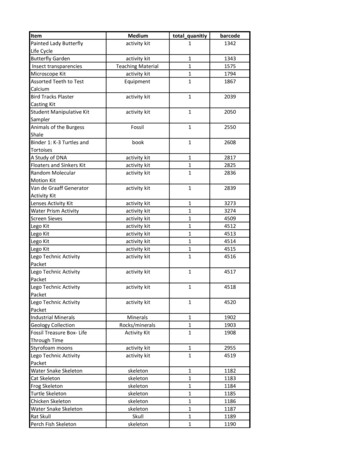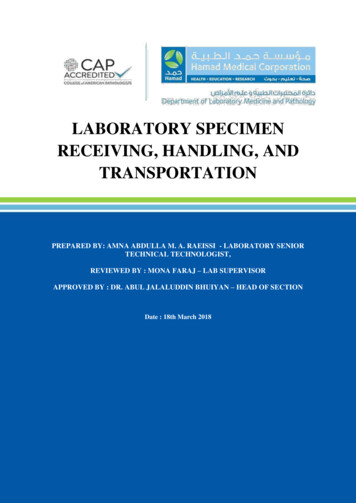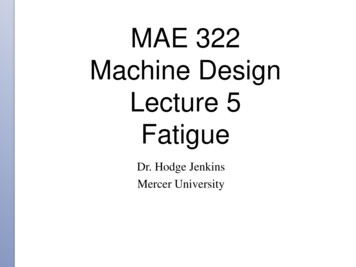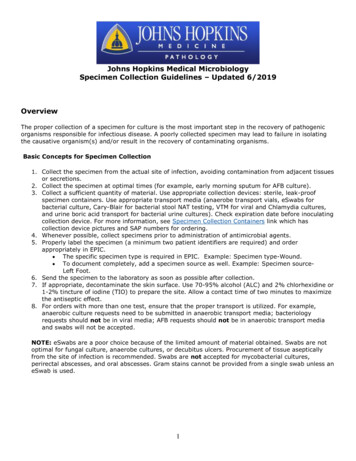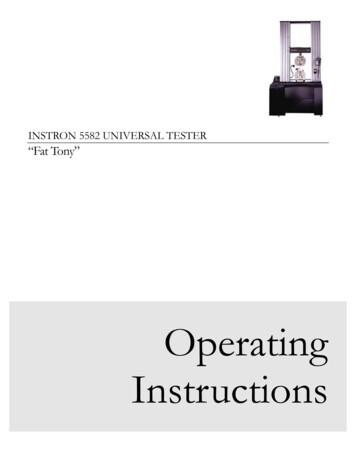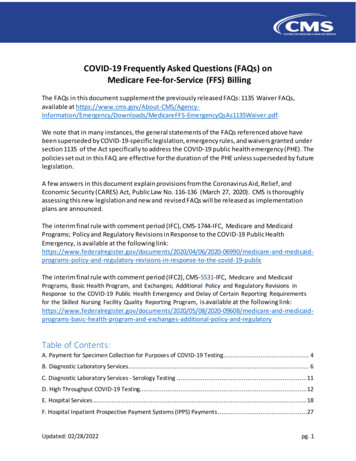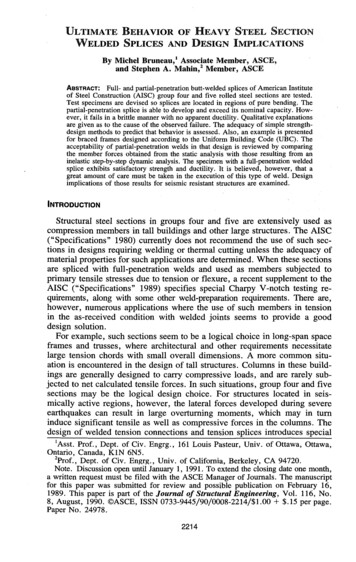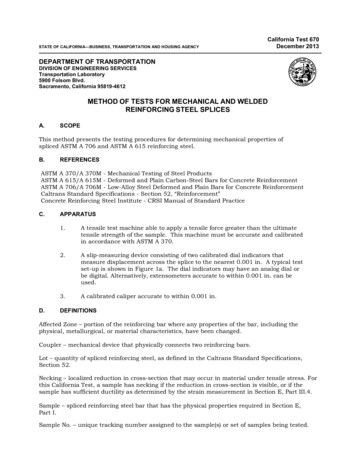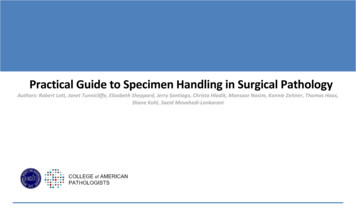
Transcription
Practical Guide to Specimen Handling in Surgical PathologyAuthors: Robert Lott, Janet Tunnicliffe, Elizabeth Sheppard, Jerry Santiago, Christa Hladik, Mansoor Nasim, Konnie Zeitner, Thomas Haas,Shane Kohl, Saeid Movahedi-Lankarani
Practical Guide to Specimen Handling in Surgical PathologyAUTHORS:Robert Lott, Janet Tunnicliffe, Elizabeth Sheppard, Jerry Santiago, Christa Hladik, Mansoor Nasim, Konnie Zeitner, Thomas Haas, Shane Kohl, Saeid Movahedi-LankaraniINTRODUCTIONIn spite of the abundant guidelines and recommendations published for specimen handling and testing in a clinical pathology laboratory, relatively little literature is available for guidance of specimen handlingin a surgical pathology laboratory. This document does not relate to cytologic or clinical pathology samples.The following comprehensive table is intended to serve as a general guideline for proper specimen handling from the time it is taken from the patient to the time a completed slide of the specimen is given to apathologist for interpretation.DISCLAIMER:This document was created by members of the CAP/NSH Histotechnology Committee and is intended to serve as a guideline ONLY and NOT AN absolute recommendation for specimen handling. Each laboratoryis advised to use these guidelines as a starting point and modify certain parameters to fit state and local institutional requirements, as appropriate. Regulatory references, standards, and CAP checklist items citedin the guideline are current at the time of publication of this version of the guideline. It is recommended that the user confirm all references used are the latest version available. The use of the informationcontained in this guideline does not guarantee compliance with the CAP accreditation requirements or regulations from other accrediting organizations. Some information may be different or more stringentthan the published CAP Checklists.It is the intent of the CAP/NSH Histotechnology Committee to update this document every 2 years or when required and have the updated version of the document available to members on the College ofAmerican Pathologists (CAP) and National Society for Histotechnology (NSH) websites.1Version: 9.0Revised: April 2020
Table of Contents:Part I – Specimen Collection and HandlingA.B.C.D.E.F.G.H.Patient Identification Proper Labeling .Transport Media .Completion of Requisition .Recommendations for Tissue Collection and Handling Accessioning .Handling prior to Gross Examination .Intra-operative Consultation .pg. 4pg. 5pg. 7pg. 10pg. 17pg. 26pg. 27pg. 29Part II – Laboratory ProcessesA.B.C.D.E.F.G.H.Guidelines Tissue Cassette Identification .Fixation Parameters .Processing .Embedding .Microtomy Staining Coverslipping .pg. 32pg. 38pg. 39pg. 46pg. 52pg. 53pg. 58pg. 712Version: 9.0Revised: April 2020
VERSIONREVISION DATE2.0November , 2013REVISION1. Addition of disclaimer on cover page2. Addition of version control3.0November , 20144.0January, 20155.0September, 20151. Updated to reflect LAP Committee 2015 Checklist changes6.0November, 20151. Updated to reflect corrected formalin solution to tissue ratio with references7.0September, 20171. Updated to reflect August 21, 2017 CAP Checklist edition changes8.0September, 20181. Updated to reflect August 22, 2018 CAP Checklist edition changes2. Updated to reflect review of all references9.0April, 20201. Revised per comments received from CAP Chair review1. Updated references – CAP Checklists: ANP, COM, GEN , 4-21-20142. All references reviewed3. Table of contents added1.2.3.4.Updated to reflect June 4, 2020 CAP Checklist edition ChangesUpdated to reflect review of all referencesUpdated Table of ContentsUpdated Title Page and organizational logos3Version: 9.0Revised: April 2020
PART II. SPECIMEN COLLECTION and HANDLINGRelated CAP Checklist RequirementsGuideline SectionStatement2018 EditionCollection and HandlingA. Patient Identification Patient is to be identified in a manner that respects patient privacy with respect totheir medical records and medical data.Laboratory General Checklist, GEN.41303 Patient Confidentiality Patient's identity must be verified at the time of specimen collection.Laboratory General Checklist, GEN.40490 Patient Identification At least two acceptable patient-specific identifiers are required for patientidentification:oooooFull nameAssigned identification number e.g. health record / master index numberDate of birthPhoto on government issued or other photo ID card, such as driver's licenseOther specific personal identifiersLaboratory General Checklist, GEN.40491Primary Specimen Container LabelingAdditional ReferencesHealth Insurance and Portability andAccountability Act (HIPAA).Clinical Laboratory Standards InstituteCLSI - GP33A, Accuracy in Patient andSample Identification; 2011: Vol. 30No7.International Standard ISO 15189:2012- Medical Laboratories; section 5.4 Pre-examination Processes4Version: 9.0Revised: April 2020
Collection and HandlingB. Proper Labelling Specimen is labeled in the presence of the patient Specimen label must contain at least two patient-specific identifiers: oFull patient nameoAssigned identification number e.g. health record / master index numberoDate of BirthCustomizable label elements – additional identifiers that are acceptable:oPatient genderoAccession or requisition numberoOrdering physicianoSource of specimen (e.g. skin)oSite of specimen (e.g. left side of chest)Laboratory General Checklist, GEN.40490 –Patient IdentificationLaboratory General Checklist, GEN. 40100 Specimen Collection Manual ElementsLaboratory General Checklist, GEN. 40491 Primary Specimen Container LabelingClinical Laboratory Standards InstituteCLSI – Auto12-A Specimen Labels:Content and Location, Fonts and LabelOrientation: 2011: Vol. 31 No7.Standardized format for label information should be implemented.oLast name, first nameoDate of Birth – DD –MMM- YYYY i.e. 12 MAR 1968oGender M, F, U ( unknown), T ( Transgender), I (Intersex)All Common Checklist, COM.06100 –Primary Specimen Container LabelingAll Common Checklist, COM.06200 Secondary Specimen Container LabelingWritten documentation developed for the correct positioning of the label on thecollection container.oBrown RW, Della Speranza V, AlvarezJO, et al. Uniform labeling of blocks andslides in surgical pathology: Guidelinefrom the College of AmericanPathologists Pathology and LaboratoryQuality Center and the National Societyfor Histotechnology. Arch Pathol LabMed. 2015;139(12):1515-24.Do not attach label to the container lid (in whole or part)5Version: 9.0Revised: April 2020
o Do not overlap label resulting in patient data being coveredWritten documentation for the correction of labelling errors – to be followed whenspecimens cannot be replacedLaboratory General Checklist, GEN.40492 –Specimen Label CorrectionLaboratory General Checklist, GEN.40825 Specimen ID All subsequent labelling of patient samples (blocks and slides) must follow samepatient-specific identifying process.Laboratory General Checklist, GEN.40491 Primary Specimen Container Labeling Submitted slides may be labeled with a single patient-specific identifier but twoare preferred.Collection and HandlingB. Proper Labelling All parameters used for standard specimen labelling are to be followed. The unique specimen bar code or RFID label must be consistent across allapplications: specimen container, requisition label, cassette and slide labels. Barcode and RIFD specifications within a failure rate established by your facilityfor patient care. Barcode label stock or RFID chip validated to withstand chemicals andprocessing used for anatomic pathology specimens.i. Barcoding and/orRadio FrequencyIdentification(RFID)Laboratory General Checklist, GEN.40825 Specimen IDZarbo RJ, Tuthill JM, D’Angelo R, et al.The Henry Ford Production System:reduction of surgical pathology inprocess misidentification defects by barcode-specified work processstandardization. Am J Clin Pathol. 2009;131:469-477.Clinical Laboratory Standards InstituteCSLI – Auto02-A2 LaboratoryAutomation: Bar Codes for SpecimenContainer Identification: 2006: Vol. 25No 29.6Version: 9.0Revised: April 2020
Bar coding and/or RFID documentation must be validated and maintained. Automatic identification scanning equipment is validated for accuracy andresistant to chemicals used for anatomic pathology handing. If used for specimen chain of custody tracking, the barcode or RFID trackingsystem must have intelligent location capabilities.Collection and HandlingC. Transport Media i. No media / salineCollection, handling and submission procedures must be made available to allhealth care workers involved in the collection, labeling, submission and transportof specimens to the pathology laboratory. All specimens must be placed in leak proof container. Specimens should be transported to the laboratory immediately after collection. Specimens that cannot be immediately transferred must be refrigerated untilLaboratory General Checklist, GEN.40100 Specimen Collection Manual ElementsClinical Laboratory Standards InstituteCLSI – GP33A, Accuracy in Patient andSample Identification; 2011: Vol 30No7.All Common Checklist, COM.06000,Specimen Collection ManualLaboratory General Checklist, GEN.74500Specimen Transport ProceduresInternational Standard ISO 15189:2012- Medical Laboratories; section 16 Preexamination.Laboratory General Checklist, GEN.40125 –Handling of Referred Specimenstransferred to the Pathology laboratory. For specimens submitted to the laboratory from remote sites, there is adocumented tracking system to ensure that all specimens are actuallyreceived.Specimens transferred from distant referral site to pathology lab should beshipped under temperature-controlled conditions to avoid over heating or freezingLaboratory General Checklist, GEN.40511 Specimen Tracking/LabelingLaboratory General Checklist, GEN.40535 Specimen Transport QM7Version: 9.0Revised: April 2020
Policies regarding courier service should be established All specimens must be properly packaged and labelled, indicating materials to betransported prior to shipping to a centralized or referral laboratory. To avoid drying of tissues that are not immediately placed into formalin at time ofprocurement:owrap solid tissue masses (i.e. lymph node or breast lump) in salinedampened gauze prior to placement in labelled container (certain biopsiesmay need special handling)oadd a small volume of saline to tissue with insufficient naturally occurringfluids (i.e. conceptus for embryopathology/genetic studies)Laboratory General Checklist, GEN.40530 Specimen TrackingBancroft J, Gamble M. Theory andPractice of Histological Techniques, 6thed. New York, NY: Churchill Livingston;2008Laboratory General Checklist, GEN.40535 Specimen Transport QMCarson F, Hladik C. Histotechnology ASelf- Instructional Text, 3rd ed. Chicago,IL: ASCP Press; 20098Version: 9.0Revised: April 2020
Collection and HandlingC. Transport Media ii. Different fixativesCollection, handling and submission procedures must be made available to allhealth care workers involved in the collection, labelling, submission and transportof Specimens to the pathology laboratory.Laboratory General Checklist, GEN.40100 Specimen Collection Manual ElementsAll Common Checklist, COM.06000,Specimen Collection Manual All specimens must be placed in leak proof container.Laboratory General Checklist, GEN.74500Specimen Transport ProceduresVolume of fixative to tissue ratio must be included in the collection/handling andsubmission procedures. i.e. 10% neutral buffered formalin volume should be 1520 times the volume of the specimen. Safety Data Sheets (SDS) must be made available to all staff handling fixatives.International Standard ISO 15189:2012- Medical Laboratories; section 5.4 Pre-examination Processes.Bancroft J, Gamble M. Theory andPractice of Histological Techniques, 6thed. New York, NY: Churchill Livingston;2008Specimens must be placed in appropriate fixative as specified incollection/handling and submission procedure. Clinical Laboratory Standards InstituteCLSI - LIS09A, Standard guideline forcoordination of clinical laboratoryservices within electronic health recordenvironment and networkedarchitectures; 2003: Vol. 23 No 15.Carson F, Hladik-Cappellano C.Histotechnology A Self- InstructionalText, 4th ed. Chicago, IL: ASCP Press;2014Laboratory General Checklist, GEN.76100Chemical Safety Document AccessBrown RW. et. al., HistologicPreparations Common Problems andTheir Solutions. College of AmericanPathologists, 20099Version: 9.0Revised: April 2020
All specimen containers containing fixatives must have appropriate OSHAChemical labels attached.Laboratory General Checklist, GEN.40125 –Handling of Referred Specimens Specimens transferred from distant referral site to Pathology lab should beshipped under temperature-controlled conditions to avoid over heating orfreezing.Laboratory General Checklist, GEN.40511 Specimen Tracking/LabelingSpecimens containers should be shipped following appropriate regulations for theshipping and handling of formalin i.e. hard sided container with absorbent packingmaterial.Laboratory General Checklist, GEN.40535 Specimen Transport QMClinical Laboratory Standards InstituteCLSI – GP 17-A3, Clinical LaboratorySafety, 3rd edition; 2012: Vol 32 No 9.Occupational Health and SafetyAdministration. Occupational Safety &Health Standards 1910.1200 toxic andHazardous mlCollection and HandlingD. Completion of requisitionWritten procedures on how to properly complete a pathology requisition must bemade available to all health care workers involved in the collection, labelling,submission and transport of specimens to the pathology laboratory.Laboratory General Checklist, GEN.40700 Requisitionsi. Patient identifiers Written or electronic request for patient testing from authorized person.Laboratory General Checklist, GEN.40930 Authorized Requestor10Version: 9.0Revised: April 2020
Required patient identifiers to be included on the requisition / test order:o Patient’s nameLaboratory General Checklist, GEN.40750 Requisition Elementso Unique identifier i.e. health record or master index numberClinical Laboratory Standards InstituteCLSI - GP33A, Accuracy in Patient andSample Identification; 2011: Vol 30No7.o Date of BirthInternational Standard ISO 15189:2012- Medical Laboratories; section 5.4- Preexamination Processes.o SexCollection and HandlingD. Completion of Written or electronic request for patient testing to include:requisitionii. Specimenname/type/siteoooooooooPatient identifiers as listed aboveName and address or other suitable identifiers of the authorized personrequesting the testName and address or other suitable identifier for the individual responsiblefor receiving the test resultsName and address of the laboratory submitting the specimenTest and or tests to be performedProcedure performedSpecimen site – if more than one specimen is collected during a singleprocedure; each specimen should be individually identified by anatomic siteand or specimen typeDate and time of procedure or specimen collectionDate specimen receivedLaboratory General Checklist, GEN.40930 Authorized RequestorLaboratory General Checklist, GEN.40750 Requisition ElementsClinical Laboratory Standards InstituteCLSI - GP33A, Accuracy in Patient andSample Identification; 2011: Vol 30No7.International Standard ISO 15189:2012- Medical Laboratories; section 5.4 Pre-examination ProcessesLaboratory General Checklist, GEN.40900 Specimen Date Received11Version: 9.0Revised: April 2020
Collection and HandlingD. Completion of Written or electronic request for patient testing to include:orequisitioniii. Pertinent clinicalClinical history – any additional information relevant or necessary for aspecific test to ensure accurate and timely testing and reporting of results,including interpretation if required.Laboratory General Checklist, GEN.40750 Requisition ElementsHealth Insurance and Portability andAccountability Act (HIPAA).Clinical Laboratory Standards InstituteCLSI - GP33A, Accuracy in Patient andSample Identification; 2011: Vol 30No7.historyInternational Standard ISO 15189:2012- Medical Laboratories; section 5.4- Preexamination ProcessesCollection and HandlingD. Completion of The procedure date should be indicated on the requisition following standardizedformat DD - MM - YYYY (i.e. 04 JAN 2012). The requisition must have a space for the documentation of the warm ischemictime by the physician obtaining the specimen or designate. Warm ischemic time:The time measured from the interruption of the blood supply to the tissue/tumorby the surgeon to the excision time of the tissue specimen.requisitioniv. Proceduretime/datea. Time removedfrom patient(Warm ischemic time) Information should be available in the laboratory for review and/or appear on thepatient accession.Laboratory General Checklist, GEN.40750 Requisition ElementsAllison KH, Hammond EH, Dowsett M,McKernin SE et al. Estrogen andProgesterone Receptor Testing inBreast Cancer American Society ofClinical Oncology/College of AmericanPathologists Guideline Update. ArchPath Lab Med. Early Online Release.doi: 10.5858/arpa.2019-0904-SAInternational Standard ISO 201664:2020 - Molecular in vitro diagnosticexaminations – Specifications for preexamination processes for formalinfixed and paraffin-embedded (FFPE)tissue for – Part 4: In situ detectiontechniques: section 6 – Inside thelaboratory.12Version: 9.0Revised: April 2020
Collection and HandlingD. Completion of The requisition should have a space for the documentation of the cold ischemictime by the physician obtaining the specimen or designate. Cold ischemic time:The time from excision of the specimen from the surgical field to the time thetissue is placed in fixative.requisitioniv. Proceduretime/dateb. Time fixative Information should be available in the laboratory for review and/or appear on thepatient accession. The requisition should have a space for the documentation of the date and timethe specimen is placed in fixative by the physician obtaining the specimen ordesignate.added(if required)(cold ischemic time)Anatomic Pathology Checklist, ANP.22983 –Fixation – HER2 and ER Predictive MarkerTestingLaboratory General Checklist, GEN.40125 –Handling of Referred SpecimensAllison KH, Hammond EH, Dowsett M,McKernin SE et al. Estrogen andProgesterone Receptor Testing inBreast Cancer American Society ofClinical Oncology/College of AmericanPathologists Guideline Update. ArchPath Lab Med. Early Online Release.doi: 10.5858/arpa.2019-0904-SAClinical Laboratory Standards InstituteCLSI – MM13, Collection, Transport,Preparation, and Storage of Specimensfor Molecular Methods: 2020.Compton CC, Robb JA, AndersonMW, Berry AB, et.al. Preanalytics andPrecision Pathology: PathologyPractices to Ensure Molecular Integrityof Cancer Patient Biospecimens forPrecision Medicine. Arch Path LabMed. Nov 2019, Vol. 143, No. 11(November 2019) pp. 1346-1363.International Standard ISO 201664:2020 - Molecular in vitro diagnosticexaminations – Specifications for preexamination processes for formalinfixed and paraffin-embedded (FFPE)tissue for – Part 4: In situ detectiontechniques: section 6 – Inside thelaboratory.13Version: 9.0Revised: April 2020
Collection and HandlingD. Completion of The requisition must have a space for documentation of the date and time ofarrival of the specimen in the AP laboratory to allow for calculation of thetransport time.Laboratory General Checklist, GEN.40535 Specimen Transport QM Transport time:The time tissue specimen was collected in the operating room/doctor’soffice/clinic until it is received in the pathology laboratory for processing (this isthe time point when the specimen is going to be grossly assessed).Laboratory General Checklist, GEN.40530 Specimen Trackingrequisitioniv. Proceduretime/datec. Time received inlab (Transport time)Information must be available in the laboratory for review and/or appear on thepatient accession.Clinical Laboratory Standards InstituteCLSI – MM13, Collection, Transport,Preparation, and Storage of Specimensfor Molecular Methods: 2020.Collection and HandlingD. Completion ofrequisitioniv. Proceduretime/dated. Calculation of The laboratory has the responsibility to calculate and document total time thespecimen was kept in fixative for required specimens (i.e. breast).To include:oTime specimen held in the operating roomoTransport time from remote site to AP laboTime the specimen was kept in fixative while in the lab ( i.e. largespecimens like colon, breast mastectomy were opened/cut to allow forpenetration of fixative)oTime the specimen(s) are kept in cassettes after grossingoTime in fixative onboard the tissue processortotal fixation timeAllison KH, Hammond EH, Dowsett M,McKernin SE et al. Estrogen andProgesterone Receptor Testing inBreast Cancer American Society ofClinical Oncology/College of AmericanPathologists Guideline Update. ArchPath Lab Med. Early Online Release.doi: 10.5858/arpa.2019-0904-SAAnatomic Pathology Checklist, ANP.22983 –Fixation – HER2 and ER Breast CancerPredictive Marker TestingAllison KH, Hammond EH, Dowsett M,McKernin SE et al. Estrogen andProgesterone Receptor Testing inBreast Cancer American Society ofClinical Oncology/College of AmericanPathologists Guideline Update. ArchPath Lab Med. Early Online Release.doi: 10.5858/arpa.2019-0904-SAWolff AC, Hammond EH, Hicks,DG,Dowsett,M, et al: American Society ofClinical Oncology/College of AmericanPathologists Guideline UpdateRecommendations for HumanEpidermal Growth Factor Receptor 2Testing in Breast Cancer,Journal ofClinical Oncology, Vol 31, No. 31, Nov12013: pp. 3997-4013.14Version: 9.0Revised: April 2020
Collection and HandlingD. Completion ofrequisition Tissue handling requirements should be standardized and reported on everyspecimen. 10 % neutral buffered formalin is the recommended fixative. All samples must receive a minimum of six(6) hours of 10% neutral bufferedformalin fixation Recommended fixation time is 6-72 hrs. for estrogen and progesteronereceptors.Laboratory General Checklist, GEN.40100 Specimen Collection Manual Elementsiv. Proceduretime/datee. Fixation time forbreast tissuespecimens Recommended fixation time is 6 to 72 hours for Her2neu receptors. Fixation time must be documented, and the following is an example of how thedata could be recorded on the requisition:Time frameWarm ischemic timeCold ischemic timeTransport time from OR /physician office /clinic tolaboratory to time of primary examinationTime whole specimen held for additional fixation priorto placing in cassettesTime cassettes are held prior to loading onto tissueprocessorFixation time on tissue processor (delay time plusprocessing time)Total Fixation timeMinutesHoursLaboratory General Checklist, GEN.40125 –Handling of Referred SpecimensAnatomic Pathology Checklist, ANP.22983 –Fixation - HER2 and ER Predictive MarkerTestingAnatomic Pathology Checklist, ANP.23004 Digital Imaging – Preanalytic Testing PhaseValidationWolff AC, Hammond ME, AllisonKH, Harvey BE, et al. Human EpidermalGrowth Factor Receptor 2 Testing inBreast Cancer: American Society ofClinical Oncology/College of AmericanPathologists ClinicalPractice Guideline Focused Update.Arch Path Lab Med; Nov 2018, Vol.142, No. 11. pp. 1364-1382Allison KH, Hammond EH, Dowsett M,McKernin SE et al. Estrogen andProgesterone Receptor Testing inBreast Cancer American Society ofClinical Oncology/College of AmericanPathologists Guideline Update. ArchPath Lab Med. Early Online Release.doi: 10.5858/arpa.2019-0904-SAClinical Laboratory Standards InstituteCLSI – MM13, Collection, Transport,Preparation, and Storage of Specimensfor Molecular Methods: 2020.Werner M, Chott A, Fabiano A, BattiforaH. Effect of Formalin Tissue Fixationand Processing onImmunohistochemistry. AmericanJournal of Surgical Pathology. 24. July2000:1016-1019.Spruessel A, Steimann G, Jung M, LeeSA, Carr T, Fentz AK, Spangenberg J,Zornig C, Juhl HH, David KA. Tissueischemia time affects gene and proteinexpression patterns within minutesfollowing surgical tumor excisionBioTechniques, Vol. 36, No. 6, June2004:1030–1037.15Version: 9.0Revised: April 2020
Petersen BL, Sorensen MC, PedersenS, Rasmussen M. Fluorescence In-situHybridization on Formalin-fixed andParaffin-Embedded Tissue: Optimizingthe Method. AppliedImmunohistochemistry & MolecularMorphology. 12(3) September2004:259-265.Tanney A, Kennedy RD. DevelopingmRNA-based biomarkers from formalinfixed paraffin-embedded tissue.Personalized Medicine (2010) 7(2),205–211.Compton CC, Robb JA, AndersonMW, Berry AB, et.al. Preanalytics andPrecision Pathology: PathologyPractices to Ensure Molecular Integrityof Cancer Patient Biospecimens forPrecision Medicine. Arch Path LabMed. Nov 2019, Vol. 143, No. 11 pp.1346-1363.Collection and HandlingD. Completion ofrequisition Establish standardized fixation times for all routine and specialized biopsies. Document the recommended fixative for routine and specialized biopsies. Establish specimen acceptance and rejection policies related to specimenfixation.iv. Proceduretime/datef. Fixation time forNON-breastspecimensAll Common Checklist, COM.06300 –Specimen Rejection CriteriaDepartment of Health and HumanServices, Centers for Medicare andMedicaid Services. Clinical laboratoryimprovement amendments of 1988;final rule. Fed Register. 2003(Jan 24):[42CFR493.1283(a)(3)]Compton CC, Robb JA, AndersonMW, Berry AB, et.al. Preanalytics andPrecision Pathology: PathologyPractices to Ensure Molecular Integrityof Cancer Patient Biospecimens forPrecision Medicine. Arch Path LabMed. Nov 2019, Vol. 143, No. 11(November 2019) pp. 1346-1363.16Version: 9.0Revised: April 2020
Collection and HandlingD. Completion of requisitionWhen alternate identifier is used for authorized person requesting test orreceiving test results (medical billing number, hospital ID number), the numbermust be unique and traceable in the LIS.Laboratory General Checklist, GEN.40750 Requisition ElementsHealth Insurance and Portability andAccountability Act (HIPAA).v. RequestingClinical Laboratory Standards InstituteCLSI - GP33A, Accuracy in Patient andSample Identification; 2011: Vol 30No7.physiciana. contact informationavailable in LISInternational Standard ISO 15189:2012- Medical Laboratories; section 5.4 Pre-examination Processes.Collection and HandlingE. Recommendations for The use of surgical instruments driven by heat should be avoided or limited whenpossible. Thermal injury has been known to interfere with diagnosis. The use of surgical instruments should be avoided or limited as much aspossible when handing the specimen to prevent crushing or damaging the tissue.Tissue Collection andHandlingi. Limiting Artifacts.Association of Surgical Technologists(AST) Recommended Standards ofPractice for Handling and Care ofSurgical Specimens. www.ast.orga. Thermal injuryCollection and HandlingE. Recommendations forTissue Collection andHandlingAssociation of Surgical Technologists(AST) Recommended Standards ofPractice for Handling and Care ofSurgical Specimens. http://www.ast.orgi. Limiting Artifactsb. Crush injury17Version: 9.0Revised: April 2020
Collection and HandlingE. Recommendations for All tissue should be placed in fixative as soon as possible after removal from thebody, unless special studies are ordered that might be affected by the availablefixative. If fixative cannot be added in a timely manner, the specimen should be placed ina sterile basin and kept moist with sterile saline or wrapped in saline-dampenedsponges until the specimen can be properly placed in fixative. All unfixed specimens should be transported to the pathology laboratory as soonas possible and refrigerated until placed into appropriate fixative.Tissue Collection andAnatomic Pathology Checklist, ANP.11250 Adequate storageHandlingi. Limiting Artifactsc. Drying artifactAssociation of Surgical Technologists(AST) Recommended Standards ofPractice for Handling and Care ofSurgical Specimens. www.ast.orgMakary MA, Epstein J, Pronovost PJ,Millman EA, Hartmann EC, FreischlagJA. Surgical specimen identificationerrors: A new measure of quality insurgical care. Surgery. 2007.141:450455.Laboratory General Checklist, GEN.40535 Specimen Transport QMCollection and HandlingE. Recommendations for Health care facility policy and procedure should be followed for the propercollection, labeling, and transportation of the specimen to the pathologydepartment. All fresh specimens are to be submitted to the pathology department as soonas possible with instructions for special testing or processes. All unfixed specimens should be transported to the pathology laboratory assoon as possible and refrigerated until placed into appropriate fixative. Specimens not in fixative should be placed in a sterile basin and kept moistwith sterile saline or wrapped in saline-soaked sponges until the specimencan be properly placed in fixative.Tissue Collection andHandlingii. Tissue Transporta. Allfreshspecimens Confirmation with surgeon on other types of diagnostic studies to beperformed, including Gram stain, acid fast and mycological studies.Clinical Laboratory Standards InstituteCLSI – MM13, Collection, Transport,Preparation, and Storage of Specimensfor Molecular Methods: 2020.Makary MA, Epstein J, Pronovost PJ,Millman EA, Hartmann EC, FreischlagJA. Surgical specimen identificationerrors: A new measure of quality insurgical care. Surgery. 2007.141:450455.Slavin L, Best MA, Aron DC. Gone butnot forgotten: The se
Version: 9.0 Revised: April 2020 1 Practical Guide to Specimen Handling in Surgical Pathology AUTHORS: Robert Lott, Janet Tunnicliffe, Elizabeth Sheppard, Jerry Santiago, Christa Hladik, Mansoor Nasim, Konnie Zeitner, Thomas Haas, Shane Kohl, Saeid Movahedi-Lankarani
